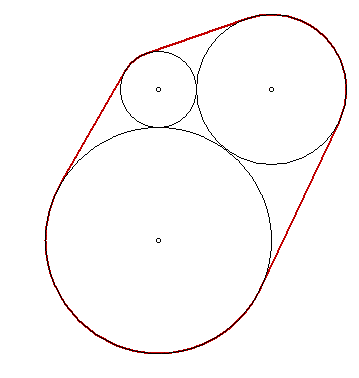 Author
Author |
Topic: Wrapped Circles (Read 755 times) |
|
Sir Col
Uberpuzzler
    

impudens simia et macrologus profundus fabulae

Gender: 
Posts: 1825
|
 |
Wrapped Circles
« on: Apr 14th, 2004, 10:29am » |
 Quote Quote  Modify Modify
|
An inelastic band (of negligible thickness) fits perfectly around two touching circles with radii 1 cm and 3 cm. Find the exact length of the band.
What would be the length of a band surrounding three touching circles with radii 1 cm, 2 cm, and 3 cm?
|
|
 IP Logged IP Logged |
mathschallenge.net / projecteuler.net
|
|
|
Noke Lieu
Uberpuzzler
    

pen... paper... let's go! (and bit of plastic)

Gender: 
Posts: 1884
|
 |
Re: Wrapped Circles
« Reply #1 on: Apr 14th, 2004, 4:47pm » |
 Quote Quote  Modify Modify
|
Aw, its much easier when all three are the same size 
But I love these.
The centre of the two circles (A,B) are 4cm apart.
Draw common tangents of A and B. Gives the angles (if you draw the trap, remove the 4x1 rectangle, leaves a right triangle sides 2, 12.5,4) Hey hey, 30,60,90.
so the band's points of contact/leaving of the circles are 120o apart relative to their centres.
This means that the band has 2x12.5+(2pi/3)+(12pi/3) (that is there are two lengths from the gap between the circles, 1/3 of the circumference of the small circle and 2/3 the circumference of the big one.
Simplifies down to (14pi/3)+2x12.5
Will figure out how to get the sqrt sign shortly. Gives someone a chance to get the second part.
[e} okay, that's easy... will wait a while before answering the next bit- I have a time zone advantage here... have left the [pi] [sqrt] simple- they hide better[/e]
|
| « Last Edit: Apr 14th, 2004, 4:53pm by Noke Lieu » |
 IP Logged IP Logged |
a shade of wit and the art of farce.
|
|
|
Sir Col
Uberpuzzler
    

impudens simia et macrologus profundus fabulae

Gender: 
Posts: 1825
|
 |
Re: Wrapped Circles
« Reply #2 on: Apr 14th, 2004, 5:41pm » |
 Quote Quote  Modify Modify
|
That's true about hiding [sqrt] and [pi]; when you highlight the region to read the hidden text they kind of invert making them difficult to read. I tend to write sqrt() in hidden text.
Very nice, Noke Lieu!
You could write 2sqrt(12)+14pi/3=4sqrt(3)+14pi/3. I suppose we could say that the first part is all wrapped up! 
Actually, as an extension to the first part...
Given that R=3r, find the perimeter, P, in terms of r.
Can you find any other relationships between r and R, such that P can be given in terms of [pi]?
|
| « Last Edit: Apr 15th, 2004, 2:31am by Sir Col » |
 IP Logged IP Logged |
mathschallenge.net / projecteuler.net
|
|
|
Barukh
Uberpuzzler
    

Gender: 
Posts: 2276
|
For those who prefer vizualization - the drawing for the second question is attached...
|
|
 IP Logged IP Logged |

|
|
|
Sir Col
Uberpuzzler
    

impudens simia et macrologus profundus fabulae

Gender: 
Posts: 1825
|
 |
Re: Wrapped Circles
« Reply #4 on: Apr 15th, 2004, 4:28am » |
 Quote Quote  Modify Modify
|
Thanks for that, Barukh; I'm sure it will be helpful.
Out of interest, what did you use to create your drawing?
|
|
 IP Logged IP Logged |
mathschallenge.net / projecteuler.net
|
|
|
Barukh
Uberpuzzler
    

Gender: 
Posts: 2276
|
 |
Re: Wrapped Circles
« Reply #5 on: Apr 15th, 2004, 4:47am » |
 Quote Quote  Modify Modify
|
on Apr 15th, 2004, 4:28am, Sir Col wrote:| Out of interest, what did you use to create your drawing? |
|
I use an old demo version of Geometry Sketchpad - a dynamic geometry tool. You may want to visit the following page to learn more about it.
|
|
 IP Logged IP Logged |
|
|
|
Barukh
Uberpuzzler
    

Gender: 
Posts: 2276
|
 |
Re: Wrapped Circles
« Reply #6 on: Apr 15th, 2004, 9:01am » |
 Quote Quote  Modify Modify
|
on Apr 14th, 2004, 5:41pm, Sir Col wrote:Given that R=3r, find the perimeter, P, in terms of r.
Can you find any other relationships between r and R, such that P can be given in terms of [pi]? |
|
As stated, the question is too general. Probably, you had in mind to restrict the relations somehow (e.g. R/r is rational, and/or [pi] has a rational coefficient in P)?
|
|
 IP Logged IP Logged |
|
|
|
Sameer
Uberpuzzler
    

Pie = pi * e
Gender: 
Posts: 1261
|
 |
Re: Wrapped Circles
« Reply #7 on: Apr 20th, 2004, 7:23am » |
 Quote Quote  Modify Modify
|
Using basic geometry for two touching circles, I came to this formula
For derivation r != R, but it also holds for r=R, we have
P=4*sqrt(r*R) + 2*pi*R - 2*(R-r)*tan-1(2*sqrt(r*R)/(R-r))
Using original problem of r=1,R=3, we get the same answer as Noke had.
Note: I think the term inside tan-1 is of the form 2xy/(x2-y2) which can be converted to tangent formulas and get rid of tan-1. Maybe I will leave it to someone else.
|
| « Last Edit: Apr 20th, 2004, 7:24am by Sameer » |
 IP Logged IP Logged |
"Obvious" is the most dangerous word in mathematics.
--Bell, Eric Temple
Proof is an idol before which the mathematician tortures himself.
Sir Arthur Eddington, quoted in Bridges to Infinity
|
|
|
|
 WRITE MATH!
WRITE MATH!
 Home
Home  Help
Help  Search
Search  Members
Members  Login
Login  Register
Register WRITE MATH!
WRITE MATH!
 Home
Home  Help
Help  Search
Search  Members
Members  Login
Login  Register
Register